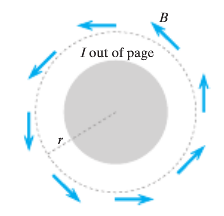Magnetic Field of a Long Thick Wire Using Ampere's Law: Difference between revisions
No edit summary |
|||
| Line 22: | Line 22: | ||
This results in the equation: <math>{B = \frac{μ_0I}{2πr}}</math> which is equal to <math>{\frac{μ_02I}{4πr}}</math>. This is the equation for the magnetic field of a long thick wire that is found using the Biot-Savart law. | This results in the equation: <math>{B = \frac{μ_0I}{2πr}}</math> which is equal to <math>{\frac{μ_02I}{4πr}}</math>. This is the equation for the magnetic field of a long thick wire that is found using the Biot-Savart law. | ||
== | ==Examples== | ||
===Simple=== | |||
What is the magnetic field at a point 0.03 m away from a wire that has a current of 7 amperes? | |||
Solution: <math>I=7</math> and <math>r=0.03</math>. So inserting this into the formula gives <math>{B = \frac{μ_0(7)}{2π(0.03)}}</math>. This results in 4.67e-5 T | |||
===Middling=== | |||
A long straight wire suspended in the air carries a conventional current of 7.4 amperes in the -x direction as shown (the wire runs along the x-axis). At a particular instant an electron at location < 0, -0.004, 0 > m has velocity < -3.5 e5, -4.2 e5, 0 > m/s. What is the magnetic field due to the wire at the location of the electron? | |||
Solution: Using the same formula as above and also implementing the right hand rule this equates to < 0, 0, 3.7e-4 > T. | |||
===Hard=== | |||
Using the same values as in the middling problem calculate the magnetic force on the electron due to the wire. | |||
Solution: The formula for magnetic force is <math>qv×B</math>. So by using the value for B computed above and calculating the cross product between B and qv we find that this equals < 2.49e-17, -2.07e-17, 0 > N. Don't forget that because this is the force on an electron q is negative. | |||
== See also == | == See also == | ||
Revision as of 21:49, 5 December 2015
claimed by Baron Hall
The Main Idea
This section explains how to find the magnetic field near a long thick wire using Ampere's Law. Finding the magnetic field using Ampere's Law is very simple compared to finding it using the Biot-Savart law.
Formula for Ampere's Law
How to Find Magnetic Field of A Long Thick Wire
To find the magnetic field [math]\displaystyle{ B }[/math] at a distance [math]\displaystyle{ r }[/math] from the center of the long wire apply Ampere's Law. By the symmetry of the wire [math]\displaystyle{ B }[/math] will always be constant and tangential to the circular path at every point around the wire.
The path integral [math]\displaystyle{ {{\oint}d\vec{l}} }[/math] in this situation is equal to the circumference of the circular path around the wire. This is equal to [math]\displaystyle{ 2πr }[/math].
Using the formula above and plugging in [math]\displaystyle{ {d\vec{l}} }[/math] we have: [math]\displaystyle{ {B(2πr) = μ_0I} }[/math]. To solve for [math]\displaystyle{ B }[/math] divide both sides by [math]\displaystyle{ 2πr }[/math].
This results in the equation: [math]\displaystyle{ {B = \frac{μ_0I}{2πr}} }[/math] which is equal to [math]\displaystyle{ {\frac{μ_02I}{4πr}} }[/math]. This is the equation for the magnetic field of a long thick wire that is found using the Biot-Savart law.
Examples
Simple
What is the magnetic field at a point 0.03 m away from a wire that has a current of 7 amperes?
Solution: [math]\displaystyle{ I=7 }[/math] and [math]\displaystyle{ r=0.03 }[/math]. So inserting this into the formula gives [math]\displaystyle{ {B = \frac{μ_0(7)}{2π(0.03)}} }[/math]. This results in 4.67e-5 T
Middling
A long straight wire suspended in the air carries a conventional current of 7.4 amperes in the -x direction as shown (the wire runs along the x-axis). At a particular instant an electron at location < 0, -0.004, 0 > m has velocity < -3.5 e5, -4.2 e5, 0 > m/s. What is the magnetic field due to the wire at the location of the electron?
Solution: Using the same formula as above and also implementing the right hand rule this equates to < 0, 0, 3.7e-4 > T.
Hard
Using the same values as in the middling problem calculate the magnetic force on the electron due to the wire.
Solution: The formula for magnetic force is [math]\displaystyle{ qv×B }[/math]. So by using the value for B computed above and calculating the cross product between B and qv we find that this equals < 2.49e-17, -2.07e-17, 0 > N. Don't forget that because this is the force on an electron q is negative.
See also
See the page on Ampere's Law for a more in depth look at the law itself: Ampere's Law
For more applications of Ampere's Law see: Magnetic Field of a Toroid Using Ampere's Law and Magnetic Field of Coaxial Cable Using Ampere's Law
Further reading
Books, Articles or other print media on this topic
External links
Internet resources on this topic
References
This section contains the the references you used while writing this page

